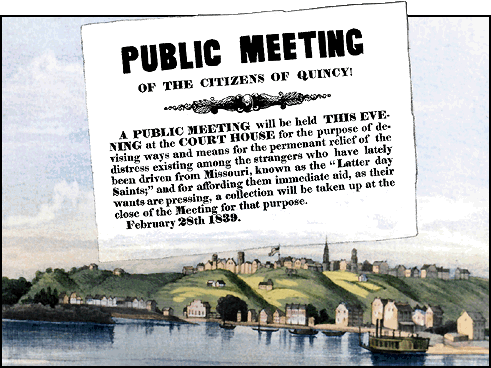
FEATURE ARTICLES


|
Strange Bedfellows: |
| Sidney Rigdon and the Quincy Whig: 1839-1841 | |
|
The frigid and stormy winter of 1838-39 was a faith-testing low point in the experience of the early Latter Day Saints. Most were forced to flee the State of Missouri as destitute refugees, but the Mormon followers of Joseph Smith struggled with grim determination to reach shelter at the nearest point of reasonable safety, the eastern shore of the Mississippi River. Once across the river they congregated, a leaderless and broken people, in and around Adams County, Illinois, and particularly in the county-seat of Quincy. This bustling port was then the largest town on the upper Mississippi and a rival of St. Louis. The well-known liberality of its citizens (it was the gateway to the abolitionists' "underground railway") and the abundance of goods stored in its waterfront storehouses attracted the fleeing Saints like a magnet. Ten years later, when the Mormons were once again gaining national attention, a writer for the Southern Literary Messenger recalled the arrival of these fugitive Mormons: They began to arrive in Quincy and its vicinity, during the winter of 1828-9. They were, for the most part, wretchedly poor, scantily supplied with clothing, and almost destitute of food. They were compelled for want of houses, to camp out for weeks together at that inclement season, in the river bottoms, under such shelter as poles and blankets afforded them. They were the most humble and submissive of men. They described their wrongs and sufferings in the most moving terms: but still, rather in the language and tone of unresisting martyrs, than those of defeated and vindictive partizans. Every body was filled with compassion. Contributions were freely made for their relief, in money and necessaries, both by the public authorities and by individuals. Employment was given to them on farms, in workshops, and in private families: and many of them distributed themselves through the adjoining counties, and even in distant parts of the State, pursuing various avocations. There seemed to be a fair prospect of their being gradually absorbed in the general population of the country: and their inoffensive demeanor conciliated the good will of their new neighbors, while it confirmed the prejudice against Gov. Boggs and the Missourians. Although fearful at first of their church being decimated and their lifeline to divine realms being severed, these all but penniless escapees from Missouri did not have to wait long for the arrival of the requisite charity and leadership. Even as the more recent saintly arrivals hunkered down along the river bottoms in wagons, tents and the occasional shed of a benevolent Gentile, a select circle of Mormon escapees who were blessed with greater renown (and far deeper pockets) were already warming their feet at the toasty fireside of Mormon sympathizer, Judge John Cleveland, four miles east of Quincy. Miraculously, all three members of the Saints' ruling First Presidency escaped Missouri's jails and secured their safety in Illinois before the last of that cruel winter's storms had subsided. The famous Mormon brethren, "Presidents" Joseph and Hyrum Smith slipped away from a Missouri sheriff on the 15th of April and the latter day prophet was safely sheltered at the Cleveland farm by the afternoon of the 22nd. There he found his companion Emma and their children already settled in the gracious care of his faithful follower (and future plural wife) Sister Sarah Cleveland. An earlier important Mormon guest, "President" Sidney Rigdon, had already gathered his belongings and departed the Cleveland homestead by the time of Joseph's arrival. Prophet Smith would renew his long-standing acquaintance with this peculiar third member of the Mormon multi-monarchy a week later in a nearby hamlet (a spot on the river which Joseph would one day rename "Nauvoo"). The veiled intercourse of such latter day "prophets, seers, and revelators" is, of course, unrecoverable from this temporal distance; but their public wheelings and dealings can be documented without undue effort. And the sifting of that recorded evidence provides clues to the motives and methods of the Mormon masters. This paper examines some of the lesser known activities of Sidney Rigdon, along with those of Joseph Smith and their close associates during a time of testing and transition. In particular, it concentrates upon the image of Mormon President Sidney Rigdon as it was reflected in a novel newspaper, the highly partisan and recalcitrant Quincy Whig. The paper also seeks to help explain the inconstant portrayal of this illusive Mormon figure by the Gentile journalists and editors of ante-bellum Quincy. |
The posting of this paper is still in progress
A preliminary version may be found on-line at:
SolomonSpalding.com paper no. 1